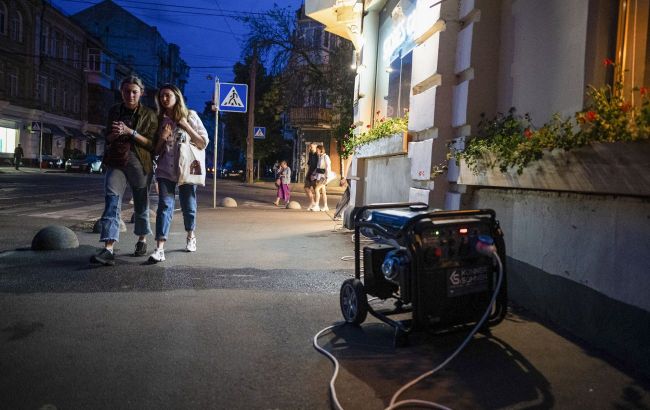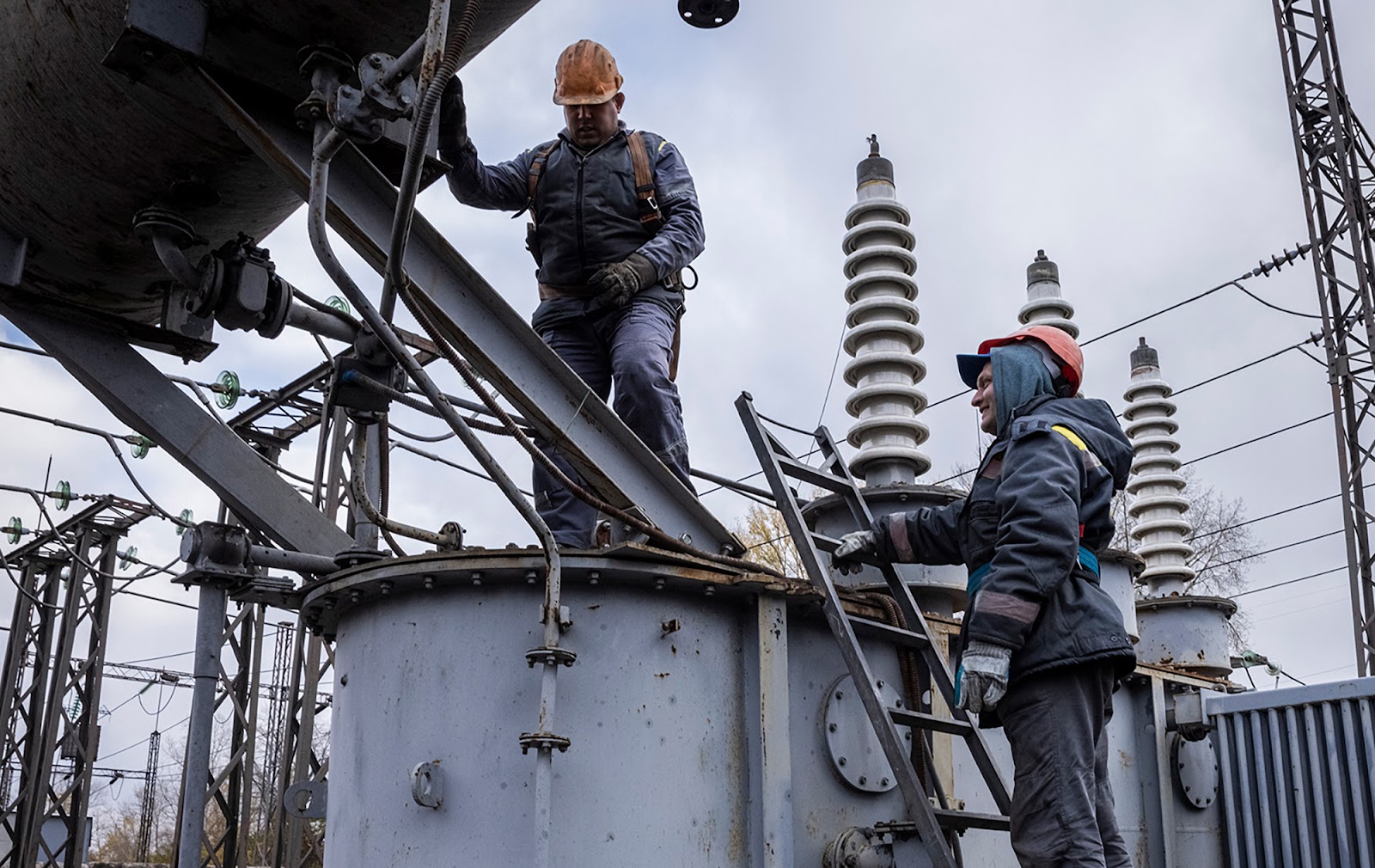No blackout, but with power outages: What awaits Ukraine's energy sector during 2024
 Power outages in Ukraine may become longer (photo: GettyImages)
Power outages in Ukraine may become longer (photo: GettyImages)
The energy supply situation in Ukraine is tough, and there is little hope for improvement in the coming months. There will be no total blackout, but the energy shortage may increase and become much longer. Read more about the prospects for Ukraine's electricity supply by the end of the year in the RBC-Ukraine article.
Contents
- Three stages of Russian destruction of Ukrainian energy sector
- How to restore lost generation
- 0% loan for solar power plants
- Restoring half of lost generation is positive scenario
In the first half of 2023, Ukraine's energy sector suffered more losses from Russian shelling than in 2022-2023. Russian massive attacks on Ukraine's energy infrastructure began in the third decade of March. In the first two weeks, Russia destroyed 6 GW of generation facilities, which is equal to the capacity of Zaporizhzhia NPP, which came under the control of Russian troops in the first days of the massive Russian offensive.
By the end of June, there had already been eight major attacks on energy facilities. The losses exceeded 9 GW, which is almost half of Ukraine's total capacity. Ukraine has lost about 80% of its maneuverable generation, two hydroelectric power plants have been decommissioned, and only 27% of all thermal power plants are operating.
Three stages of Russian destruction of Ukrainian energy sector
Experts name three conditional stages of destruction of the Ukrainian energy sector starting in 2022. The first is the Russian seizure of ZNPP in 2022. Then the generation immediately decreased by 6 GW, which was produced by 6 units of the plant.
The second is the Russian destruction of distribution networks and transformers in the winter of 2022-2023. Last winter, almost half of the 94 high-voltage transformers and more than 40% of Ukrenergo's trunk grids were damaged or destroyed.
The third stage is the Russian attacks on heat and hydro generation in 2024. Since March, large TPPs and CHPs have been shelled - Trypillia TPP in the Kyiv region, CHP-5 in Kharkiv, and Zmiiv TPP in Kharkiv region were destroyed.
Russian attacks on Ukraine's energy facilities continue almost every week, and the government predicts that they will continue. "Unfortunately, there is no doubt that Russia's attacks will continue. However, the power system is intact. There will be no total blackout in the country," states Energy Minister Herman Halushchenko.
Today, the Ukrainian government's main goal is to restore as much capacity as possible before the start of the heating season. This is possible in two ways.
How to restore lost generation
The first way is to restore the destroyed facilities. However, there is little hope of restoring the lost capacity. First of all, there is a shortage of equipment, which takes a long time to produce.
As a way out of the situation, Ukraine hopes that partner countries will provide equipment from their decommissioned TPPs. Negotiations are underway with Lithuania and Germany, among others.
But rebuilding destroyed facilities is a risky business. The Russians are actively practicing repeated shelling of already repaired TPPs.
At the same time, Ukraine has plans to build 1 GW of maneuverable thermal generation by the end of this year and another 4 GW in the coming years. This was stated by Volodymyr Zelenskyy at a conference on the restoration of Ukraine in Germany.
 Reconstruction of destroyed power generation facilities in Ukraine (photo: GettyImages)
Reconstruction of destroyed power generation facilities in Ukraine (photo: GettyImages)
According to Ukraine's Deputy Energy Minister Mykola Kolesnyk, several tens of MW of this volume have already been installed, and several hundred MW are in the process of being connected. "Therefore, in total, we see that we will have up to 1 GW of installed distribution generation," Kolesnyk says.
Experts admit the theoretical possibility of restoring even larger volumes of generation - up to 2 GW. However, they emphasize the high risks of repeated destruction of the restored stations.
"Nowadays, Russians are conducting more targeted attacks on the Ukrainian energy sector than before. They are trying to prevent the return of the lost capacities," says an interlocutor representing one of the major energy companies.
DTEK's management says that $350 million is needed to restore the capacity lost due to the shelling of thermal power plants. Approximately the same amount is planned for emergency repairs of energy facilities in the next tranche of support from the United States for $1.5 billion. But so far there are no details on how these funds will be used.
There are virtually no other sources of external financing for reconstruction work. It is unlikely that foreign banks and international financial organizations will agree to invest in such risky projects.
The second way is to build distribution generation. This includes gas turbine and gas piston power plants, as well as solar power plants. But even here, the prospects are not bright. According to the experts RBC-Ukraine spoke to, only up to 1.5 GW of electricity can be generated by installing small generating capacities.
As for gas, it should be enough for their operation. This is the opinion of both experts and sources in large energy companies. By the fall, it is planned to accumulate up to 13 billion cubic meters in storage facilities, and if this is not enough, Naftogaz of Ukraine has the funds to import it - a $200 million loan from the EBRD has not yet been used for this purpose.
At the same time, the load on the power system is increasing due to Russian shelling, repairs of nuclear power units, and hot weather. This is confirmed by the last decade of June, when the periods of outages increased significantly. DTEK warns that this is not the limit.
"We are approaching the summer peak. We have a peak in July and August. The reason is the high consumption of air conditioners. Generation is not increasing, but decreasing due to the Russian shelling, and the intervals between electricity supply in homes will unfortunately increase," says Dmytro Sakharuk, Executive Director of DTEK.
0% loan for solar power plants
On June 20, Volodymyr Zelenskyy chaired a meeting of the Staff of the Supreme Commander-in-Chief on energy issues. As a result, several tasks were set to prepare for the winter season, such as launching a program to stimulate solar generation and energy storage - similar to the 5-7-9 program, but at 0% for citizens. In addition, it is necessary to complete protective structures at energy facilities, decentralize energy capacities, create new ones, etc.
The Ministry of Energy of Ukraine has not yet commented to RBC-Ukraine on the possibility and mechanisms for fulfilling these tasks.
The Association of Ukrainian Cities (AUC) supports such initiatives but believes that the difference in tariffs for heat and water supply companies should be paid off first.
Oleksandr Slobozhan, executive director of the AUC, told RBC-Ukraine that the state's debt has already amounted to UAH 54 billion since the beginning of Russia's full-scale invasion of Ukraine, and a bill to address this issue has not yet been adopted. He also believes that it is necessary to extend the gas PSO, which expires on September 1, so that companies have working capital to prepare for and pass the heating season. Most importantly, Slobozhan said, the procedure for installing and connecting distribution generation should be simplified.
At the same time, the Ministry of Economy of Ukraine reported that a decision has already been made to simplify the installation of hybrid generation capacities. State support for such projects, including solar generation facilities, will be provided by the Entrepreneurship Development Fund (EDF) "through full compensation of interest rates on loans to individuals for the installation of hybrid power supply systems." "Following the provisions of the resolution, compensation is provided to one individual for one loan agreement and one metering point," the Ministry of Economy says in response to the RBC-Ukraine's request.
The maximum loan amount at 0% is set at UAH 480 thousand, and the maximum loan term is up to five years. "The mechanics will be similar to the 5-7-9 program, the CDF enters into agreements with partner banks, and citizens will be able to take out a 0% loan from banks," the Ministry of Economy says.
In addition, it is planned to abolish VAT and import duties on equipment and components for generating electricity from alternative sources, including wind turbines, solar panels, gas piston plants, electric generators, energy storage, inverters, etc.
_2.jpg) Installation of solar panels (photo: GettyImages)
Installation of solar panels (photo: GettyImages)
The Independent Association of Banks of Ukraine (IABU) does not yet know the details and mechanisms of the 0% loan program for the installation of solar power plants, so they refrain from commenting in detail.
But IABU's acting executive director, Dmytro HlinskyI, tells RBC-Ukraine that banks are usually happy to join government support programs that provide cheaper loans for borrowers.
"This helps to expand the range of potentially solvent customers and increase the working loan portfolio. However, much will ultimately depend on the specific conditions and restrictions set by the government, as well as on the reliability of the program's financing," Hlinskyi says. He reminds that the National Bank of Ukraine has already eased the requirements for credit risk assessment for special loans in the energy sector.
Restoring half of lost generation is positive scenario
If we summarize all the potential opportunities, under the positive scenario, 2 GW of destroyed generation can be restored by the end of the year and 1.5 GW of distribution generation can be used. According to Ruslan Slobodian, Head of the State Agency for State Regulation in Energy and Utilities, 1 GW of solar power can be added to this by increasing the number of individual solar stations. So far, he says, they have produced 3 GW.
But even if such forecasts come true, it will be possible to cover only half of the lost generation, and if the result exceeds expectations, about two-thirds. This is the opinion of Sviatoslav Pavliuk, Executive Director of the Association "Energy Efficient Cities of Ukraine" Sviatoslav Pavliuk.
"Even under the optimistic scenario, there will be a 20-30% deficit in the grid. If we take into account that some consumers belong to the critical infrastructure, the deficit for household consumers can be up to 40% at least. That's why there will be no electricity for most of the day. And again, this is an optimistic scenario, without taking into account new Russian attacks on the energy sector. So now the question of how to live in the absence of electricity is a matter for each house or apartment," Pavliuk says in a comment to RBC-Ukraine.
A large-scale blackout is unlikely to happen in Ukraine. It could happen if another one of the three NPPs operating in Ukraine fails for some reason to generate or transmit electricity to the unified system. The protection of NPPs is serious, but it is impossible to guarantee their safety from shelling fully.
Given that the electricity shortage cannot be fully covered, household consumers will have to take on the problem. This is what the government and energy companies are calling for. The only way out is to save money and purchase storage and generating devices.
Businesses - large, medium, and small - are actively purchasing generation equipment. The demand for energy storage devices has grown significantly, but their prices have also risen significantly. So, if you want to and have sufficient financial resources, you can improve your comfort level in the last months of summer and next winter in the face of electricity shortages. But it will be quite expensive.
Sources: public statements of officials, comments of experts and RBC-Ukraine sources, and responses of ministries to the RBC-Ukraine's requests.

